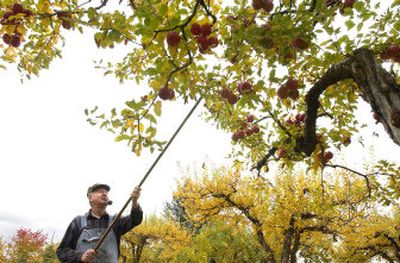Fruitful work keeps Valley history alive

The once-warm rays of daylight lay cold on the western horizon, an old man’s wheelbarrow teetered with apples and deer moved in to nibble in the Veradale orchard.
Gene Alsperger should have been walking through the back door of his Spokane Valley home for dinner, but the Air Force retiree just kept reaching into the air for one more crimson orb.
“I’m running out of time,” Alsperger said.
Time before the darkness arrives even earlier. Time before a hard frost claims all the 76-year-old cannot.
It’s a modest apple orchard Alsperger keeps on south Best Road, less than two acres of 150 gnarled trees at least four decades old. But in a good year, those trees will yield 5 tons of fruit that Alsperger almost insists on picking alone.
In a bad year, they’ll yield only a few thousand pounds.
Alsperger hesitates to tell the story of how he became a one-man fruit farm.
There’s no money in it. Alsperger gives almost all his apples to the Valley Food Bank. The satisfaction is in keeping a piece of Spokane Valley history alive.
An orchard wasn’t exactly what Gene and Betty Alsperger had in mind when they moved to South Best.
They wanted land and planned, like so many people who have built in the forgotten orchards of Spokane Valley, to give their piece of earth a clean shave. Gene Alsperger considered replacing at least some of the trees with maples but gave up on the plan after paying more than $200 each for two maples whose trunks generously were described as 2 inches in diameter.
The fog of apple blossoms the following spring, the air buzzing with bees as if the wind were blowing through tissue paper wrapped around a comb persuaded the couple to keep things as they were.
“You’d come out of the house, and the bees,” Alsperger said. “It was like B-52s.”
So many of the Alspergers’ neighbors had buried hatchets in orchards’ soft wood. In the 1960s, there were 35 acres of fruit trees here, planted by Butch and Betty Van Hees. Now, less than four acres remain.
The Van Heeses were pie-cherry farmers at first. They worked the trees with their five children and got help from Indians from the Coeur d’Alene and Colville tribes. The Indians set up summer camp in thick brush surrounding a seasonal drainage less than 100 yards from the Alspergers’ home site.
After a few years, the Van Heeses switched to apples, planting thousands of hardy apple starts. Onto each tree, they grafted the fruit they wanted.
“Those apple trees are probably 40 years old,” Betty Van Hees said. “We started out with Beacons, a tasteless apple; then we took a small part of a limb and grafted it on.”
Valley trees hung heavy with apples then, Van Hees said.
But the trees were a mere shadow of the orchards of the 1920s when more than 10,000 acres were devoted to crunchy orbs of gold or crimson.
The Spokane Valley was Washington’s apple king until Nov. 11, 1955, when winter delivered a deadly kiss – zero degrees, followed by zero the next day, minus 7 a day later and 11 below zero the day after that.
The nightly low didn’t warm above freezing for 21 days that month.
More than 80 percent of the Valley’s apple trees were gone by the time it did.
Farmers replanted, but it never was the same again, even though the light pink petals falling from trees in the 1960s could pile along a hedge like drifted snow.
Duplexes and split-level homes delivered the final blow in the 1970s.
Alsperger marvels at the trees in his yard.
Several of their trunks have hollowed with age and sprouted mushrooms, yet they still wear fall crowns of Red Delicious or Rome beauty apples.
Carefully, he raises his spindly wire basket on a stick, cradles a swollen Rome in the cage, then relieves the aging tree of the fruit’s burden.
So gentle is the harvest, the trees’ brittle branches hardly flex.
It’s one more apple in a haul of more than 3,000 pounds.
Alsperger adjusts his camouflaged ranger cap, revealing a crew cut of white hair and a scalp damp from an afternoon’s labor.
“I don’t give money to a church or a charity,” he said. “So this is my contribution.”
And for a minute, it isn’t clear if it’s the food bank or the aging forest to which he refers.